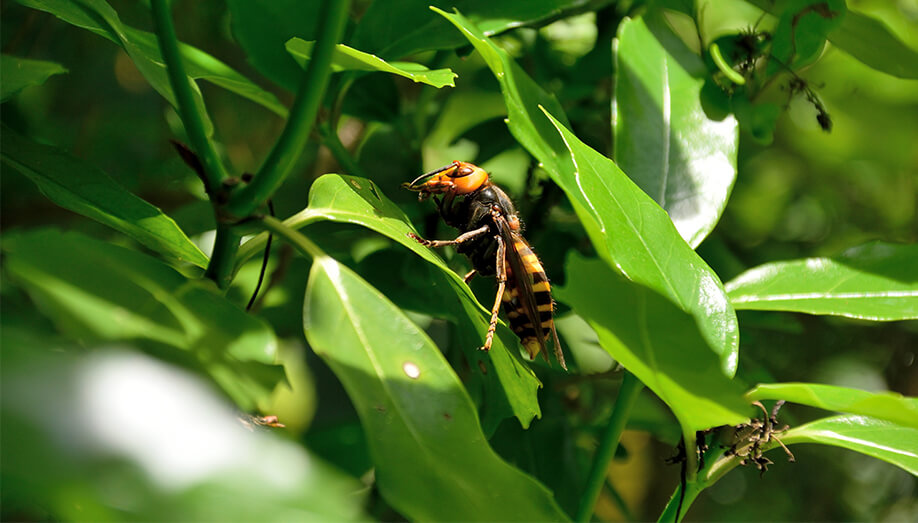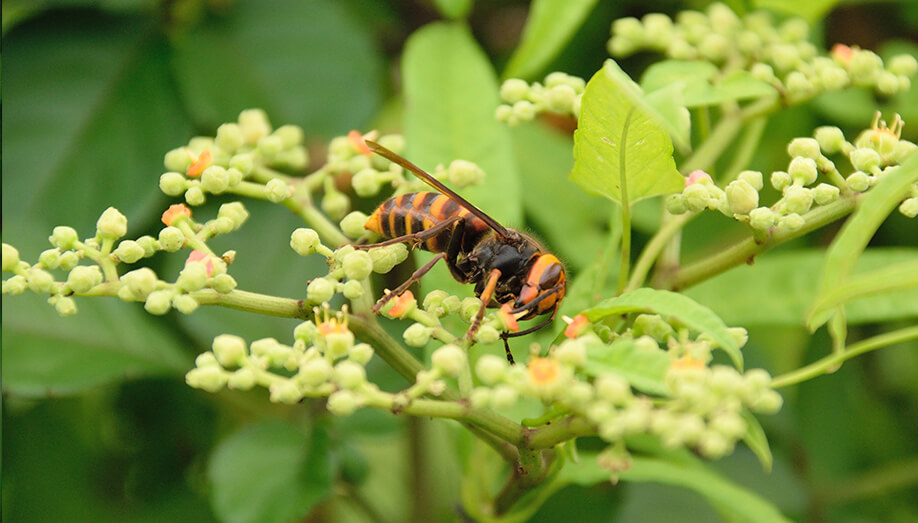In late 2019, the Washington State Department of Agriculture (WSDA) reported the first sightings of the Asian giant hornet (Vespa mandarinia) in the U.S., with confirmed detections in Blaine, Washington. Nicknamed the “murder hornet” due to its aggressive nature and ability to wipe out entire honeybee colonies in hours, this invasive pest quickly became a major concern for beekeepers, entomologists, and residents.
To tackle the threat, the WSDA teamed up with local beekeepers and communities, launching an aggressive tracking and eradication campaign. Over the next two years, their efforts paid off—four nests were located and destroyed throughout Whatcom County.
The continued concern is legitimate, but just how worried should we be about these pests in 2025? Keep reading to find ou more!
What is a Murder Hornet?

The name “murder hornet” was drummed up through social media to evoke fear and intrigue, but it is more commonly known as the Asian Giant Hornet. It is native to East Asia, South Asia, Mainland Southeast Asia, and parts of Russia.
These massive hornets build nests underground, often taking over burrows previously made by rodents or other critters. They prefer damp, dark places and can dig as deep as two feet below the surface.
But why the nickname? It’s partly due to their aggressive nature toward other bees, hornets, and wasps. It only takes a small handful of these hornets roughly an hour to kill off a bee hive, slaughtering the entire hive in an effort to feed.
What Do Murder Hornets Look Like?

The Asian Giant Hornet is the largest hornet on the planet, big enough that residents of Japan have referred to it as a “great sparrow bird” because of their sheer size. Measuring about two inches long with a wingspan of around three inches, their buzz is loud enough to hear before you even see them.
Queens, workers, and drones all share similar features, but their sizes can vary. Queens are the largest, while workers are smaller but otherwise identical in appearance. Drones (males) are about the same size as workers but lack stingers—something true for all insects in the Hymenoptera order.
Regardless of sex or size, the Asian Giant Hornet’s head is a lighter shade of orange with brown antennae and a yellow/orange color at the base. Its large mandibles are also orange and contain a distinct black tooth that it uses for digging.
Its thorax is dark brown, with two large grey wings attached. The Asian Giant Hornet’s abdomen has alternating bands of color consistent with the coloring on its head; generally, these color bands will be dark brown/black and yellow/orange. The stinger on this hornet is a massive ¼ inch long, capable of penetrating bee suits or additional layers of clothing, and packing a painful and highly venomous sting.
As there can be a number of similarities to other species of hornet or wasp, it can be helpful to educate yourself on other local insects. Here is a guide on the Asian Giant Hornet, including spotting differences from some other species.
How potent is the venom of the Murder Hornet?

The sting of an Asian giant hornet is no joke. Packed with damaging neurotoxins and injected in large volumes, their venom can be incredibly harmful. While it’s not the most lethal wasp venom by weight, the sheer amount delivered by each sting makes it especially dangerous.
A single sting usually isn’t fatal to most people unless they have a severe allergy. But when it comes to multiple stings, even those without allergies face serious risks. Deaths from murder hornet stings are typically caused by anaphylactic shock or cardiac arrest, especially if someone is swarmed by a nest of these aggressive hornets.
Despite its potential to be lethal to humans, parts of the world where the Asian Giant Hornets are indigenous report very few deaths. In areas where these hornets are native, like Japan, they cause an estimated 12 to 26 deaths per year. And that number includes all bee, wasp, and hornet stings combined.
But if you do get stung? Expect pain. Masato Ono, a prominent entomologist from Tamagawa University in Tokyo, described the sensation of being stung “like a hot nail being driven into my leg!”
Other entomologists and social influencers have ranked the giant hornet sting as one of the most painful in the world, only falling behind the notorious executioner wasp, whose sting can cause searing pain that lasts up to 36 hours.
Do Murder Horneta Sting For No Reason?
Good news: Murder hornets aren’t out to get you, at least, not without a reason. Like most hornets, Asian giant hornets (Vespa mandarinia) generally won’t sting unless provoked. But if you try to catch, kill, spray, or otherwise mess with them, your chances of getting stung skyrocket.
These hornets are fiercely territorial and won’t hesitate to defend their nest if they feel threatened. Accidentally bump into a lone murder hornet while it’s out foraging? You’re probably fine. But if you disturb a nest—that’s a whole different beast.

Are Murder Hornets Still a Threat in 2025?
Tracking Murder hornet populations has been a priority in the Pacific Northwest since the first confirmed sightings back in late 2019. Initial estimates suggested only a small number of Asian giant hornets made their way into the state, and most sightings were concentrated in the northwest corner, particularly in Whatcom County.
Between 2019 and 2021, the Washington State Department of Agriculture (WSDA) took aggressive action, deploying 60 sap traps across Whatcom County and urging residents to set experimental bottle traps baited with orange juice and rice cooking wine. Their efforts expanded to 330 additional traps throughout the region to prevent these giant hornets from establishing a foothold.
By the end of 2021, the WSDA had destroyed four nests in Whatcom County. Continued monitoring and extensive trapping efforts paid off. From 2022 to 2024, the WSDA maintained its vigilant surveillance across high-risk areas. During this period, no confirmed Murder hornet sightings were reported.
After three years of thorough monitoring and zero detections, the WSDA officially declared Washington State (and the United States as a whole) free from northern giant hornets in December 2024. This milestone highlights the success of early detection and rapid intervention, safeguarding local ecosystems and honeybee populations.
Should I be afraid of the Murder Hornet?
Good news: For most of us, Murder Hornets aren’t a direct threat. While their sting can be painful and potentially dangerous, these hornets are not actively hunting humans.
The real concern has always been their impact on European honey bees. Unlike their Asian counterparts, European honey bees haven’t developed natural defenses against the Asian Giant Hornet. These beneficial pollinators are already on the decline, and we can’t afford to let things get much worse.
Asian Honey Bee species, however, have adapted and come up with an interesting defense mechanism to protect against the Murder Hornet. When attacked, the honey bees will swarm and form a “bee ball” around the attacking hornet, and then feverishly flap their wings, raising the body temperature of the attacking hornet, essentially cooking it to death.
Our biggest concern is whether the Asian Giant Hornet will be able to establish a stronghold here in the United States once more, potentially wiping out our honey bee population. However, the likelihood of these hornets spreading is very minimal, so there is little reason to be afraid for our personal safety.
We hope we’ve been able to answer most of your questions about the infamous Murder Hornet. If you have any additional questions, please feel free to reach out to us!

